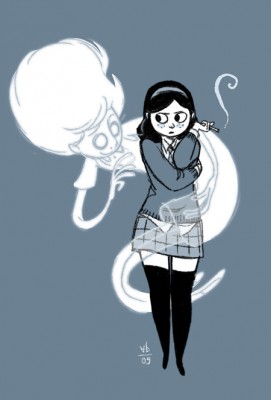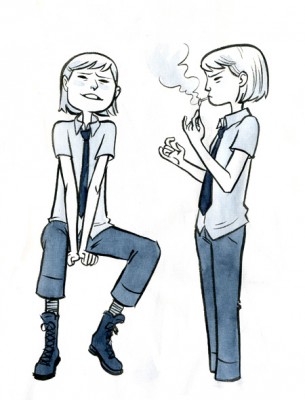Reviewer: Emera
Date read: 2.28.2012
Book from: Personal collection, via Vertical, Inc.
(Yeah, the cover design is pretty punishingly cute. And also, classy! Oh Vertical, you know how to win my heart.)
The friend who egged me on in my desire to read this series, which has the proud distinction of siring the “princely girl” anime subgenre (i.e. Rose of Versailles, Revolutionary Girl Utena), described it as “nonstop shoujo bullshit.” Honestly, I can’t add much more to that than “but there’s lots of wacky gender stuff, too!!”
Adapted from the cover blurb:
“A mischief-making angel’s prank goes too far when the newborn princess of Silverland ends up with two hearts — one male and one female. Since the laws of Silverland only allow a male heir to ascend the throne, Princess Sapphire is raised as a prince. Princess Knight is the fast-paced tale of a heroic princess who can beat any man at fencing, yet is delicate and graceful enough to catch the eye of Prince Charming. Filled with narrow escapes, treacherous courtiers, dashing pirates, meddlesome witches, magical transformations and cinema-worthy displays of derring-do, you’ll be swept right along as Sapphire tackles one challenge after another.”
“One challenge after another” is only too right: the plot twists (potions, prisons, a desirous island queen, hellish pacts, Swan Lake references, etc. etc.) are addictive to a point, but past that point get exhaustingly frenetic. My patience was also tried by the fact that Sapphire is actually pretty dull. Apart from intermittent feats of gallantry, she doesn’t accomplish much other than throwing herself into defeatist fits of tears and mooning with disturbing passivity over her square-jawed and also dull main squeeze, Prince Franz. It comes as a relief to those of us rooting for a pluckier hero/ine that Tezuka has Sapphire close out her gender-bending with a bang: even though she ultimately prefers traditional femininity (she declares her desire to just get married in a dress, please), she’s still up for a swordfight even after her “boy heart” has been revoked.
One more photo and further thoughts on characters and gender after the cut:
Continue reading Princess Knight, by Osamu Tezuka (1953-6) E



